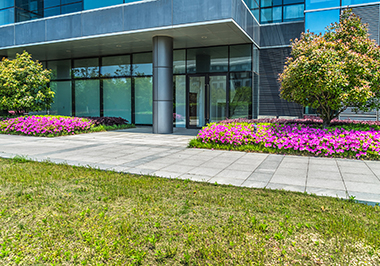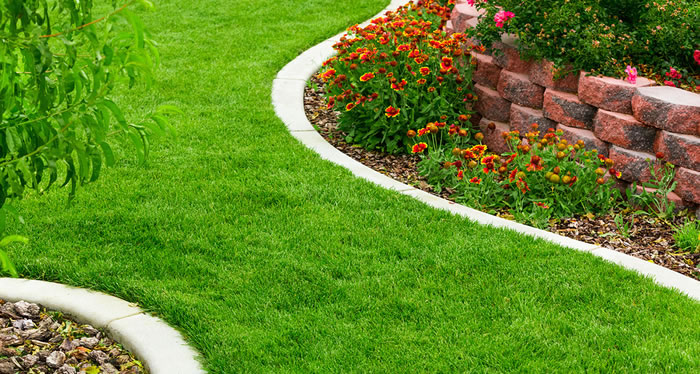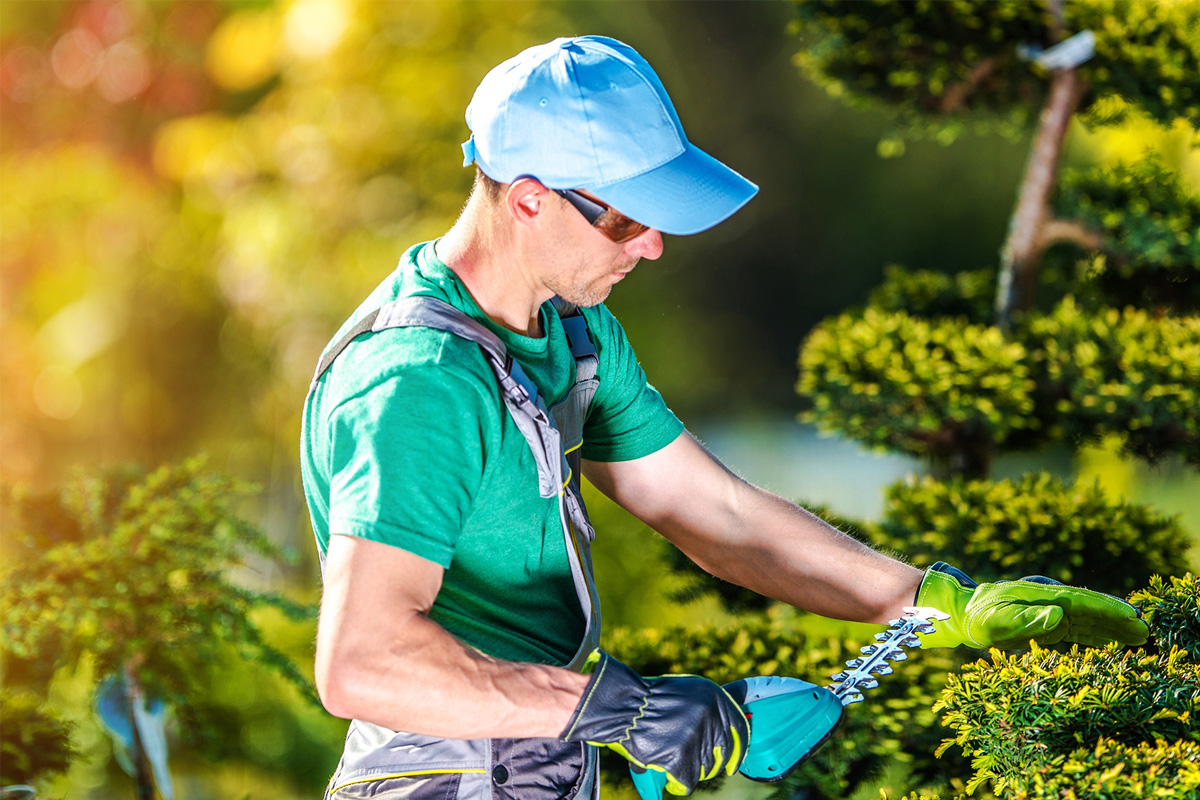Understanding the Comprehensive Scope of Functions in Specialist Landscaping Services
The substantial extent of expert landscaping services encompasses a selection of basic elements - landscaping services. It includes landscape design principles, plant choice, and hardscaping attributes. Additionally, it deals with watering systems and maintenance methods. Each aspect plays an important role in developing functional and aesthetically pleasing outdoor areas. Recognizing just how these components collaborate can disclose much about the art and scientific research of landscaping. The trip right into this complex field is just beginning.
Landscape Design Principles
Effective landscape design principles are important for creating unified exterior spaces that improve both visual charm and functionality (Learn More). These principles guide the arrangement of components within the landscape, guaranteeing a natural aesthetic experience. Key parts consist of balance, which disperses visual weight evenly; percentage, which relates the dimension of numerous elements to every other and the space; and unity, which produces a sense of wholeness with consistent themes and products

Plant Selection and Setup
In the domain name of professional landscaping, plant selection and installment play an important function in accomplishing a growing garden. Emphasizing indigenous plant benefits, seasonal considerations, and the particular dirt and sunlight requirements of each types assures a lasting and cosmetically pleasing landscape. Cautious preparation in these locations not only boosts biodiversity but also promotes lasting eco-friendly health and wellness.
Native Plant Advantages
Why should homeowners think about indigenous plants for their landscape design tasks? Native plants offer various advantages that improve both aesthetics and environmental sustainability. They are well-adapted to regional climates, calling for much less water and upkeep compared to non-native varieties. This durability lowers the requirement for chemical fertilizers and pesticides, promoting a healthier environment. Furthermore, indigenous plants offer environment and food for regional wild animals, consisting of pollinators, which can enhance biodiversity in houses. Their familiarity with local soil and climate condition likewise brings about better development prices and durability. By selecting native plants, property owners not only produce visually appealing landscapes but likewise add to environmental preservation, making a positive impact on their regional setting. As a result, indigenous plants stand for a smart option for landscaping tasks.
Seasonal Plant Considerations
Home owners who have welcomed native plants in their landscaping can better boost their outside spaces by thinking about seasonal plant options. By integrating plants that grow in particular periods, they can develop vibrant and visually enticing landscapes throughout the year. Springtime might introduce vibrant blooms like tulips and daffodils, while summer can display lush foliage and colorful perennials. Autumn introduces a combination of cozy tones with asters and goldenrods, while winter months can be emphasized with evergreens and decorative grasses for structure. Professional landscaping companies commonly suggest choosing plants that not only enhance existing indigenous types yet likewise give year-round rate of interest and support local wild animals. This thoughtful technique to seasonal plant selection ensures a continuously progressing and sustainable yard setting.
Soil and Sunshine Requirements
Successful landscaping rests on comprehending the certain soil and sunlight needs of plants. Different types grow under differing problems, needing a cautious evaluation of both aspects during the selection process. Dirt kinds, such as sandy, clay, or fertile, influence drain, nutrient availability, and origin advancement. Additionally, pH degrees can impact plant health, requiring soil screening to determine suitability. Sunlight needs differ significantly; some plants prosper in complete sun, while others like full or partial shade. An expert landscaper thinks about these aspects to assure peak development and aesthetic charm. By straightening plant options with the setting's certain features, landscapes can attain sustainability, strength, and visual harmony, inevitably causing effective plant facility and lasting maintenance.
Hardscaping Attributes and Construction

While landscape design typically evokes photos of rich plant and vibrant flowers, hardscaping attributes play a crucial duty in defining outdoor spaces. These components, which consist of patio areas, walkways, preserving walls, and ornamental stonework, supply structure and performance to lawns and gardens. Hardscaping uses products such as concrete, rock, block, and timber, permitting diverse styles that match the natural landscape.
The building of hardscaping functions needs cautious planning and implementation to assure sturdiness and visual charm. Professionals evaluate website problems, water drainage, and spatial partnerships to produce cohesive outside settings. Appropriate setup methods are crucial, as they protect against problems like disintegration and changing over time.
Incorporating hardscaping not only boosts the visual rate of interest of a building but also helps with outdoor activities, making it an essential aspect of detailed landscape design services. Inevitably, thoughtful hardscaping adds to both the capability and appeal of outside areas.
Watering Solutions and Water Monitoring
Effective watering systems and water monitoring are vital parts of specialist landscaping, as they assure that plants obtain the required hydration for ideal development. These systems can differ from straightforward drip irrigation configurations to innovative automated lawn sprinkler, made to meet the details demands of varied landscapes. Proper water management not just maximizes water use, reducing waste, yet also improves plant wellness and lessens illness dangers.
Landscaping experts evaluate different elements, including dirt type, plant varieties, and regional climate, to develop customized watering remedies. In addition, including rainwater harvesting techniques can further boost sustainability and effectiveness. Normal maintenance of irrigation systems is vital to preserve performance and stop leakages, which can result in water loss and raised prices (Learn More). Inevitably, a well-designed watering system plays a pivotal role in protecting the aesthetic allure of outdoor spaces while promoting ecological stewardship within specialist landscape design techniques
Lawn Care and Upkeep Methods
Lawn care read review and maintenance approaches are fundamental for attaining a lush, healthy lawn that boosts the general landscape. These approaches include numerous techniques focused on advertising excellent growth and visual allure. Normal mowing is necessary, as it encourages thick, also development while avoiding weeds from developing. Additionally, appropriate fertilizing supplies needed nutrients, with applications customized to the details yard kind and dirt conditions.
Watering techniques ought to concentrate on deep, infrequent irrigation to motivate root development, while oygenation enhances dirt structure and advertises nutrition absorption. Insect and disease monitoring is additionally vital; identifying concerns early permits effective therapies that minimize damage.
Overseeding can renew thin or broken yards, boosting density and shade (landscaping). By applying these targeted grass treatment strategies, landscape design experts can guarantee that yards remain lively and healthy and balanced throughout the periods, substantially adding to the overall appeal of the home
Seasonal Landscape Treatment and Upkeep
As the periods modification, correct landscape care ends up being vital for keeping the health and wellness and beauty of outdoor areas. Each period provides one-of-a-kind challenges and requirements. In springtime, landscape professionals concentrate on trimming, growing, and feeding to encourage development. Summer demands routine watering, weed control, and pest management to protect recently established plants.

Throughout the year, seasonal landscape upkeep guarantees that outdoor areas continue to be healthy and aesthetically attractive. Expert services can give customized maintenance plans that adjust to the particular demands of each period, permitting residential property owners to appreciate lively landscapes year-round. On the whole, seasonal care is a crucial aspect of specialist landscaping that promotes long life and aesthetic value.

Sustainable Landscaping Practices
An expanding number of home owners are embracing sustainable landscape design methods to produce environmentally pleasant outdoor rooms. These practices concentrate on saving sources, enhancing biodiversity, and lessening environmental influence. Native plants are usually chosen for their low water needs and compatibility with neighborhood ecological communities, decreasing the need for chemical fertilizers and pesticides. Rainfall gardens and permeable paving are used to manage stormwater drainage, promoting groundwater recharge and minimizing erosion.
Furthermore, lasting landscape design integrates natural horticulture methods that prioritize dirt health and advertise all-natural insect control. Efficient watering systems, such as drip irrigation and rain harvesting, assistance enhance water use. In addition, landscape designers increasingly advocate for making use of recycled materials, such as reclaimed wood and stones, to reduce waste. By adopting these lasting techniques, residential or commercial property owners not just add to ecological preservation but additionally create aesthetically pleasing environments that can love very little upkeep.
Regularly Asked Inquiries
How much time Does a Landscape Design Project Normally Require To Full?
Normally, a landscape design job can take anywhere from a couple of days to several weeks to complete, depending on the task's layout, intricacy, and size requirements. Elements such as climate and source availability also influence timelines.
What Elements Influence the Expense of Landscape Design Services?
Different aspects affect landscaping service costs, consisting of task size, layout intricacy, material top quality, labor expenses, geographical place, and seasonal need. Each aspect contributes uniquely to the total economic requirements of a landscaping task.
Are Landscaping Services Available Year-Round?
Landscaping services are typically readily available year-round, although schedule may differ based on region, seasonal weather conditions, and specific service offerings. Some services could be limited throughout severe weather or off-peak seasons.
Do Landscape Design Firms Deal Guarantees on Their Work?
Lots of landscaping firms do use warranties on their work, which can differ in length and insurance coverage. Clients are motivated to ask about details terms, ensuring they recognize what is ensured and any conditions that use.
Can I Design My Landscape Without Specialist Aid?
Yes, people can design their landscapes without specialist assistance. They might do not have knowledge in plant choice, layout, and ecological considerations, possibly leading to less efficient styles that might require costly changes later on.
In the domain name of expert landscape design, plant selection and installation play a critical role in achieving a growing yard. Property owners that have welcomed native plants in their landscape design can further boost their outdoor spaces by thinking about seasonal plant selections. Successful landscaping pivots on recognizing the certain soil and sunlight needs of plants. Efficient irrigation systems and water monitoring are essential components of expert landscape design, as they ensure that plants obtain the essential hydration for suitable development. Landscaping specialists examine different aspects, including soil kind, plant varieties, and local climate, to establish tailored irrigation remedies.